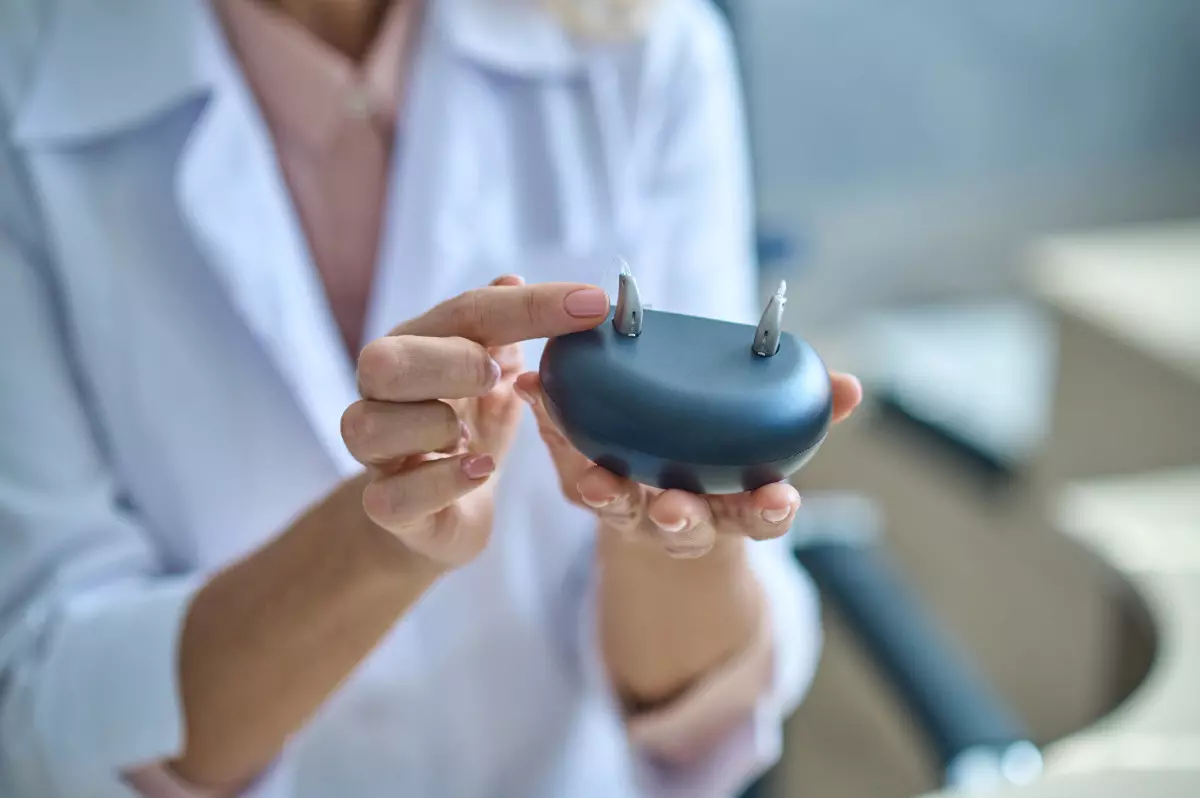Table of Contents
When you can’t hear conversations happening around you, it can be frustrating and isolating. Hearing is a key part of how we experience the world. It helps us connect with others and grow—mentally, physically, and emotionally. Unfortunately, an estimated 48 million people in the United States, or 1 in 15, experience some degree of hearing loss. While it’s the third-leading chronic health condition in the United States, only 16 percent of people age 20–69 who could benefit from hearing aids use them. This means a majority of hearing loss remains undiagnosed and untreated.
But hearing loss is about more than just the sounds you hear. It has been shown to impact mental health, with anxiety and depression at the forefront of those issues. Awareness, prevention, and treatment are how we find solutions to this growing global problem.
Read on to learn more about the impact of hearing loss and why treatment is critical to your health.
Why hearing loss matters
A number of factors can contribute to hearing loss, including genetics, smoking, head or ear trauma, aging, and overexposure to loud sounds. While causes of hearing loss can occur at any point in life, you may be more susceptible during certain periods, like childhood or after you turn 30, which is typically the earliest that age-related hearing loss will begin.
Hearing is a significant contributor to the human experience and is important to physical and cognitive development in children. It’s one of the primary methods that helps children learn to communicate basic needs and cultivate social and relational skills.
“Hearing is also a vital part of learning new concepts and engaging educationally,” says Shelley Singh, an audiologist based in Raleigh, North Carolina. “Beyond staying connected to the outside world, the ability to hear is also closely connected with balance and maintaining postures (the ability to sit upright and stand), which ultimately informs a person’s motor skills.”
Hearing loss can make conversations difficult or even impossible to follow. If a person stops communicating or trying to connect with others, their brain gradually begins to lose its ability to understand information, learn new experiences, and make sense of environmental stimuli. Ultimately, an unstimulated brain will lose its cognitive abilities over time. Research has shown that the incidence of dementia is 61 percent higher in older adults with untreated moderate to severe hearing loss than in those without significant hearing loss.
Whether hearing loss starts at birth or is a result of aging, untreated hearing loss can profoundly impact a person’s quality of life, potentially leading to social isolation, anxiety, and depression.
Hearing loss and deafness statistics
As the population ages, and concerns about young people damaging their hearing through listening devices increases, understanding the prevalence of hearing loss can be important to building greater awareness.
The prevalence of hearing loss
A study from 2017 estimates that the number of people with hearing loss in the United States is projected to almost double over the next 43 years, outpacing the overall population growth rate. The World Health Organization (WHO) projects that, by 2050, nearly 2.5 billion people worldwide will have some degree of hearing loss, with at least 700 million requiring rehabilitation and treatment. To give another perspective, hearing loss is nearly twice as prevalent as diabetes or cancer.
On an individual scale, untreated hearing loss impacts your ability to communicate with others, fully participate and learn in the education system, and cope with mental health challenges. As a society, the increasing number of people with disabling hearing loss means fewer people engaged with one another, fewer people employed, fewer people fulfilling educational requirements, and ultimately more strain on health care systems around the world.
Hearing is necessary for communication and social interaction, which maintains our emotional and psychological health. When people suffer from untreated hearing loss, they lose the ability to seamlessly connect with others, enjoy their favorite media such as TV and music, and can even be at increased risk for cognitive decline over time.
Katie Koebel, an audiologist and senior manager of audiology at HearingLife Canada
Causes of hearing loss
Studies show that some factors can impact a person’s risks of hearing loss more at certain times in their human development than in others. Therefore, the correlations below are specific to the developmental period listed. For example, exposure to meningitis as a child carries a higher risk of hearing loss compared with adults who contract meningitis.
Prenatal period
- Genetic factors are responsible for more than 50 percent of hearing loss at birth and nearly 40 percent of childhood hearing loss.
- Intrauterine infections are from exposure to viral, bacterial, and parasitic pathogens. Viral infections, like rubella and cytomegalovirus, cause up to 40 percent of all non-genetic hearing loss in children.
Perinatal period
- One out of 4 cases of hearing loss in babies is due to maternal infections during pregnancy, complications at birth (lack of adequate oxygenation experienced at the time of birth, born prematurely, and born underweight), and head trauma.
Childhood
- Meningitis may be responsible for 6 percent of hearing loss in children.
- Infections (such as measles, mumps, and meningitis) contribute to an estimated 14 percent of hearing loss in children, of which 5 percent can be profound.
- Roughly 12.5 percent of children and adolescents aged 6–19 years have permanent damage from excessive exposure to noise.
Adulthood
- Diabetes, hypertension, and kidney disease are three chronic diseases associated with hearing loss. One study found that adults with moderate to more severe hearing loss were five times more likely to experience heart disease compared with adults without hearing impairments. Further, the study found a correlation between deafness and a greater likelihood of having diabetes and cancer (any kind) when compared with all levels of hearing.
- Smoking also contributes to the prevalence of hearing loss. One study found that 65.7 percent of the smokers surveyed had hearing loss compared with only 15 percent of the non-smokers surveyed.
- Roughly 17 percent of adults age 20–69 have permanent damage from excessive noise exposure.
Hearing loss and sex assigned at birth
According to the Centers for Disease Control and Prevention (CDC), among adults age 45 and older, men are twice as likely as women to experience complete hearing loss or difficulty hearing. Researchers speculate there are two reasons for this—first, because of their lifestyle and occupation choices, and second, because they are more susceptible to certain health problems that increase the risks of hearing loss.
For instance, men are more likely than women to work in industries that use excessively loud equipment with repetitive sounds and noises. Occupations include construction (where there are 10 male workers for every female worker), the manufacturing and trucking industries (men represent 77 percent of workers), and the military. Men make up more than 75 percent of the workforce in all branches of the United States military. Not all people who work in the armed forces are exposed to loud noises on a daily basis, but many are, which is why hearing loss and tinnitus are the most common service-connected disabilities among veterans, impacting almost 1 million veterans.
According to the CDC, hearing loss is twice as common in people who have diabetes as it is in people of the same age who don’t have it. This is because diabetes can cause nerve and blood vessel damage in the ears that, over time, damage the connections between the brain and the ears. Globally, roughly 17.7 million more men than women have diabetes, putting them at a higher risk than women of developing hearing loss over their lifetime.
Tinnitus statistics
Tinnitus is a symptom of hidden hearing loss that presents as ringing or “roaring” in the ears. Today, there is no cure for tinnitus, but there are some treatments that may help reduce symptoms, like sound and behavioral therapies. The exact causes of the condition are unclear, but experts have been able to link it to the following:
- Exposure to excessively loud noises.
- Certain medications.
- Pre-existing hearing loss.
- Earwax buildup or ear infection.
In some cases, tinnitus can get better or completely go away over time. In other cases, it may worsen and become chronic. For most people, it is only a small annoyance that lasts seconds to a minute before it disappears. Others experience more intense symptoms and describe tinnitus as a trigger for their anxiety or depression based on how it affects their mood and ability to sleep. In some cases, hearing aids can be used to reduce symptoms of tinnitus by amplifying external sounds. Some hearing aids have sound therapy features that are designed to make the perception of tinnitus less noticeable.
Here’s more information about tinnitus:
- Ten percent to 25 percent of adults have tinnitus.
- Among those with tinnitus, 27 percent have experienced symptoms for more than 15 years.
- Tinnitus is one of the most common service-related disabilities, affecting more than 1.1 million U.S. veterans.
- In one study, 7.2 percent of participants reported their tinnitus as a “big” or “very big” problem compared with 41.6 percent who reported it as a “small” problem.
Hearing loss in children
A survey by the CDC shows that more than 98 percent of newborns born in 2019 in the United States were screened for hearing loss, with a prevalence of 1.7 per 1,000 babies screened showing hearing loss. The Center for Hearing and Communication estimates that around 3 million children in the United States have hearing loss.
Children may experience hearing loss from birth (congenital hearing loss) or may develop it later in their childhood (acquired hearing loss). In some cases, genetic testing may be able to help identify the causes of hearing loss. Congenital hearing impairment may arise from hereditary factors or infections during pregnancy, such as cytomegalovirus or rubella. Infants who are born early, born underweight, have health problems, or had a difficult birth are more likely to be affected by hearing loss.
Children who have untreated hearing loss may have trouble with their speech, language, and, ultimately, social development. A German study found that hearing loss diagnosis and treatment occurred around 24 months earlier in children who had undergone universal newborn hearing screening (UNHS) compared with those who had not been screened. Based on the existing studies of speech comprehension, there appears to be a significant benefit of UNHS regarding quality of life and the development of social behavior, gross motor skills, and both receptive and expressive speech skills.
“Screening protocols must be consistently adhered to as well as revised with new research to improve outcomes,” Singh says. “The brain’s ability to hear and comprehend relies on continuous exposure to environmental sounds and engaging interactions, facilitating optimal speech and language acquisition, learning, and social interaction in children.”
Many assistive technologies, like in-ear amplifiers and receivers, have been developed to keep children and young adults with hearing loss involved in the classroom and connected with teachers, professors, and other students. “The earlier hearing aids are fitted for hearing-impaired children, the linguistic functional outcomes improve drastically,” Singh adds.
Hearing loss treatment and prevention statistics
Many people don’t realize the importance of treating hearing loss. For example, a survey from 2022 asked respondents to rank the importance of 10 common health conditions, including hearing loss, cancer, heart disease, high blood pressure, obesity, Alzheimer’s disease, diabetes, vision loss, chronic obstructive pulmonary disease, arthritis, and asthma. Respondents ranked hearing loss as the third least important. In the same survey, participants answered they were two times more likely to bring their pet to an annual exam than to have their hearing checked annually. But, knowing how to prevent and treat hearing loss is important to your hearing (and overall) health.
Treatment
Studies suggest that nearly 80 percent of adults age 55–74 with hearing loss who would benefit from wearing hearing aids don’t use them. In a survey of U.S. adults who say they have difficulty hearing but don’t use a hearing aid, fewer than half of respondents had seen a hearing professional within the last five years. Some people go without wearing hearing aids or other devices because they don’t have access to treatment. For example, the WHO estimates that around half of the world’s population lacks access to essential health services. Access and the cost of hearing aids were the two main drivers behind the Food and Drug Administration’s decision to approve other-the-counter (OTC) hearing aids in the United States.
Hearing aids are the most common treatment for sensorineural hearing loss. If you have mild to moderate hearing loss, purchasing a pair of the best OTC hearing aids may be a solution for you. For severe to profound hearing loss, you’ll need to get prescription hearing aids from your audiologist.
Conductive hearing loss, which is caused by issues in the middle or outer ear, may need medical treatment. Fluid in the middle ear, earwax blockages, ear infections, tumors, damaged eardrums, or abnormal growths can all be medically diagnosed and treated. Treatment varies by condition.
The longer hearing loss goes untreated, the more likely a person is to begin to withdraw from day-to-day activities that have become strenuous due to their inability to understand their auditory surroundings. As people begin to isolate themselves, their mental health can deteriorate, and they can become depressed, which leads to a decline in other aspects of their physical health as well. Hearing care, such as hearing aids, is extremely important for maintaining social interactions and, consequently, mental health, especially as we age.
Katie Koebel, an audiologist and senior manager of Audiology at HearingLife Canada
Read our lineup of the best hearing aids to find top hearing aid options.
Prevention
Ways to protect your hearing from noise-induced hearing loss include:
- Lowering the volume on your TV, radio, or listening device.
- Wearing protection, like earplugs, noise-canceling headphones, or earmuffs when exposed to loud sounds.
- Taking listening breaks when listening to music.
- Staying away from the loudest area at a loud event like a concert or sporting event.
The WHO estimates that nearly 60 percent of hearing loss in children is due to avoidable causes that can be prevented with the implementation of public health measures, like spreading awareness about the dangers of excessive noise, making immunizations more accessible to low-income areas, and making screening more available for children.
Our final thoughts
Hearing loss is already considered a chronic health issue throughout the world and will only become more prevalent in years to come. Part of the reason is the aging baby boomer generation, as sensorineural hearing loss is the most common type of hearing loss. Early research also shows a link between noise-induced hearing loss and the high use of personal music players in children and young adults. There are a number of common factors that are known contributors to hearing loss, like genetics, intrauterine infections, infections during childhood, chronic diseases in adulthood, exposure to excessively loud noises, and the most common contributor—aging.
Even though the majority of people with hearing loss would benefit from assistive technology, like hearing aids, only 17 percent use devices to help. Untreated hearing loss can lead to anxiety, depression, and social isolation and is a known contributor to dementia and cognitive decline in older adults. If you suspect you have hearing loss, speak with your physician or an audiologist. You can also take an online hearing test, which can provide a preliminary assessment of your hearing.
- (May 2018). Hearing loss facts and statistics. Hearing Loss Association of America. Link
- Nolan LS. (2020). Age-related hearing loss: Why we need to think about sex as a biological variable. J Neurosci Res. 98: 1705–1720. Link
- Nocini, R., Henry, B. M., Lippi, G., & Mattiuzzi, C. (2023). Estimating the worldwide burden of health loss due to hearing loss. The European Journal of Public Health, 33(1), 146-148. Link
- Hoffman, H. J., Dobie, R. A., Losonczy, K. G., Themann, C. L., & Flamme, G. A. (2017). Declining prevalence of hearing loss in US adults aged 20 to 69 years. JAMA Otolaryngology– Head & Neck Surgery, 143(3), 274–285. Link
- (March 25, 2021). Quick statistics about hearing. National Institute on Deafness and Other Communication Disorders. Link
- (2021). World report on hearing. World Health Organization. Link
- (2023, August 4). Preventing noise-induced hearing loss. Centers for Disease Control and Prevention Link
- Rajendran, V., & Roy, F. G. (2011). An overview of motor skill performance and balance in hearing impaired children. Italian Journal of Pediatrics, 37, 33. Link
- Effects of hearing loss on development. American Speech-Language-Hearing Association. Link
- Walling, A.D. (2012, June 15). Hearing loss in older adults. American Family Physician. Link
- (2023, August 24). How to prevent hearing loss in young people. Cedars-Sinai. Link
- Goman, A. M., Reed, N. S., & Lin, F. R. (2017). Addressing estimated hearing loss in adults in 2060. JAMA Otolaryngology– Head & Neck Surgery, 143(7), 733-734. Link
- (February 27, 2023). Deafness and hearing loss. World Health Organization. Link
- Blackwell, D. L., Lucas, J. W., & Clarke, T. C. (2014). Summary health statistics for U.S. adults: national health interview survey, 2012. Vital and health statistics. Series 10, Data from the National Health Survey, (260), 1–161. Link
- (July 31, 2023). Meningitis infections in infants and children. American Academy of Pediatrics. Link
- Smith RJ, Bale Jr JF, White KR. Sensorineural hearing loss in children. Lancet. 2005;365(9462):879–90. Link
- (October 17, 2019) Childhood hearing loss: strategies for prevention and care. World Health Organization. Link
- Chu, K., Elimian, A., Barbera, J., Ogburn, P., Spitzer, A., & Quirk, J. (2003). Antecedents of newborn hearing loss. Obstetrics & Gynecology, 101(3), 584-588. Link
- (2023 August 4). What is hearing loss in children? Centers for Disease Control and Prevention. Link
- Glassman, J., Jordan, T., Sheu, J., Pakulski, L., & Thompson, A. (2021). Health status of adults with hearing loss in the United States. Audiology Research, 11(1), 100-111. Link
- Kumar, A., Gulati, R., Singhal, S., Hasan, A., & Khan, A. (2013). The effect of smoking on the hearing status–a hospital based study. Journal of Clinical and Diagnostic Research : JCDR, 7(2), 210-214. Link
- Madans, Jennifer H., et. al. (2021, July). Hearing difficulties among adults: United States, 2019. Centers for Disease Control and Prevention. Link
- (2023, March 17). Age-related hearing loss (presbycusis). National Institute on Deafness and Other Communication Disorders. Link
- Aging changes in the senses. University of Florida Health. Link
- Why is hearing loss more common in men than women? University of Florida. Link
- (2014) Annual benefits report: Fiscal year 2013. U.S. Department of Veterans Affairs. Link
- Diabetes and hearing loss. Centers for Disease Control and Prevention. Link
- Kautzky-Willer, A., Leutner, M., & Harreiter, J. (2023). Sex differences in type 2 diabetes. Diabetologia, 66(6), 986–1002. Link
- Zheng, Yunfang and Guan, Jianwei. (2018). Cochlear synaptopathy: A review of hidden hearing loss. Journal of Otorhinolaryngology Disorders and Treatments. Link
- Hearing and balance: Tinnitus. National Institute on Deafness and Other Communication Disorders. Link
- Del Bo, L., & Ambrosetti, U. (2007). Hearing aids for the treatment of tinnitus. In Progress in Brain Research (pp. 341–345). Link
- Bhatt, J., Lin, H. W., & Bhattacharyya, N. (2016). Prevalence, severity, exposures, and treatment patterns of tinnitus in the United States. JAMA Otolaryngology– Head & Neck Surgery, 142(10), 959. Link
- (2023). Data and statistics about hearing loss in children. Centers for Disease Control and Prevention. Link
- Hearing Loss Facts. Center for Hearing and Communication. Link
- (2023, July 14). Hearing loss in children. Johns Hopkins Medicine. Link
- Hearing aids for children. American Speech-Language-Hearing Association. Link
- Ptok, M. (2011). Early detection of hearing impairment in newborns and infants. Deutsches Arzteblatt International. Link
- (2016, September 12). FM/Assistive Listening Devices (ALD). Oregon State University Disability Access Services. Link
- Wingfield, A., & Peelle, J. E. (2012). How does hearing loss affect the brain? Aging Health, 8(2), 107–109. Link
- Gopinath, B., Wang, J. J., Schneider, J., Burlutsky, G., Snowdon, J., McMahon, C. M., Leeder, S., & Mitchell, P. (2009). Depressive symptoms in older adults with hearing Impairments: The Blue Mountains study. Journal of the American Geriatrics Society, 57(7), 1306–1308. Link
- (2023, March 3). Hearing loss and risk of dementia may be related. UCLA Health. Link
- McCormack, A., & Fortnum, H. (2013). Why do people fitted with hearing aids not wear them? International Journal of Audiology, 52(5), 360–368. Link
- (2015, November 6). Self-reported hearing trouble in adults aged 18 and over: United States, 2014. Centers for Disease Control and Prevention. Link
- Hearing health care for adults: Priorities for improving access and affordability. The National Academies of Sciences, Engineering, and Medicine. Link
- Carlson, M. L., Nassiri, A. M., Marinelli, J. P., Lohse, C. M., & Sydlowski, S. (2022). Awareness, perceptions, and literacy surrounding hearing loss and hearing rehabilitation among the adult population in the United States. Otology & Neurotology, 43(3), e323–e330. Link
- McDaid, D., Park, A., & Chadha, S. (2021). Estimating the global costs of hearing loss. International Journal of Audiology, 60(3), 162–170. Link
- Mohr, P., Feldman, J. J., Dunbar, J. L., McConkey-Robbins, A., Niparko, J. K., Rittenhouse, R. K., & Skinner, M. W. (2000). The societal costs of severe to profound hearing loss in the United States. International Journal of Technology Assessment in Health Care, 16(04), 1120–1135. Link
- Dehankar, S. S., & Gaurkar, S. (2022). Impact on hearing due to prolonged use of audio devices: A literature review. Cureus. Link




